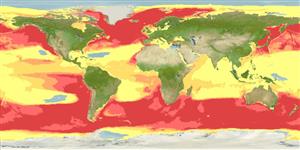Common names from other countries
Classification / Names / Names
俗名 | 同種異名 | Catalog of Fishes (gen., sp.) | ITIS | CoL | WoRMS
Environment: milieu / climate zone / depth range / distribution range
生態學
大洋性; 海洋洄游的 (Ref. 75906); 深度上下限 0 - 230 m (Ref. 1005). ; 90°N - 90°S, 180°W - 180°E
Circumglobal except the Arctic: Balaenoptera physalus physalus: Svalbard, Barents Sea, North Carolina, Portugal, Cantabrian Sea, Newfoundland, Gulf of Mexico, Greater Antilles, Faroe Islands, Norway, Canary Islands, Sea of Okhotsk, Kuril Islands, Bering Sea, Chukchi Sea, Gulf of Alaska, Sea of Japan, Japan, Taiwan, Ogasawara, Hawaii, California, Baja California, Gulf of California; Balaenoptera physalus quoyi: Ross Ice Shelf, Brazil, Gabon, Angola, Namibia, South Africa, Madagascar, Western Australia, New Zealand, Colombia, Peru, Chile (Ref. 1522).
Length at first maturity / 大小 / 重量 / 年齡
Maturity: Lm ? range ? - ? cm Max length : 2,700 cm TL 雄魚/尚未辨別雌雄; (Ref. 1394); 最大體重: 75.0 t (Ref. 1394)
The largest of the fin whales. Seen near shore, most commonly where deep water approaches the coast. Feeds on small invertebrates, schooling fishes, and squid. They are active lunge feeders (Ref. 1394). They are preyed upon by great white sharks (Ref. 32140). Following depletion of blue whale stocks, whalers shifted their attention to fin whales. Populations everywhere were substantially reduced. At present the worldwide population does not seem to appear in any immediate danger (Ref. 1394). Minimum depth from Ref. 116169.
主要參考資料
參考文獻 | 合作者 | 合作者
Jefferson, T.A., S. Leatherwood and M.A. Webber. 1993. (Ref. 1394)
IUCN 瀕危狀態 (Ref. 130435: Version 2024-1)
CITES狀態 (Ref. 108899)
人類使用
漁業: 商業性
FAO - 漁業: landings, 魚種描繪 | FishSource | 周邊海洋
工具
網路資源
Estimates based on models
Preferred temperature
(Ref.
115969): 0.2 - 4.6, mean 1.5 (based on 25596 cells).
回復力
中等的, 族群倍增時間最少 1.4 - 4.4年 (K=0.25-0.27; tm=17.5).
瀕危性
Very high vulnerability (76 of 100).
價格種類
Unknown.
